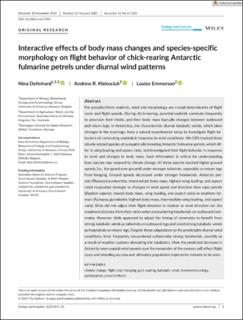| dc.description.abstract | For procellariiform seabirds, wind and morphology are crucial determinants of flight
costs and flight speeds. During chick-rearing,parental seabirds commute frequently
to provision their chicks, and their body mass typically changes between outbound
and return legs. In Antarctica, the characteristic diurnal katabatic winds, which blow
stronger in the mornings, form a natural experimental setup to investigate flight behaviors
of commuting seabirds in response to wind conditions. We GPS-tracked
three closely related species of sympatrically breeding Antarctic fulmarine petrels, which differ in wing loading and aspect ratio, and investigated their flight behavior in response to wind and changes in body mass. Such information is critical for understanding how species may respond to climate change. All three species reached higher ground speeds (i.e., the speed over ground) under stronger tailwinds, especially on return legs from foraging. Ground speeds decreased under stronger headwinds. Antarctic petrels
(Thalassoica antarctica; intermediate body mass, highest wing loading, and aspect ratio) responded stronger to changes in wind speed and direction than cape petrels (Daption capense; lowest body mass, wing loading, and aspect ratio) or southern fulmars (Fulmarus glacialoides; highest body mass, intermediate wing loading, and aspect ratio). Birds did not adjust their flight direction in relation to wind direction nor the maximum distance from their nests when encountering headwinds on outbound commutes. However, birds appeared to adjust the timing of commutes to benefit from
strong katabatic winds as tailwinds on outbound legs and avoid strong katabatic winds
as headwinds on return legs. Despite these adaptations to the predictable diurnal wind
conditions, birds frequently encountered unfavorably strong headwinds, possibly as
a result of weather systems disrupting the katabatics. How the predicted decrease in
Antarctic near-coastal wind speeds over the remainder of the century will affect flight
costs and breeding success and ultimately population trajectories remains to be seen. | en_US |

